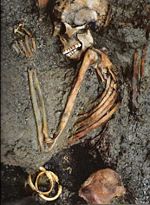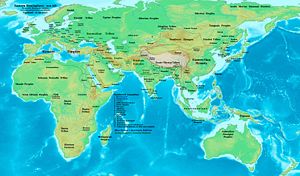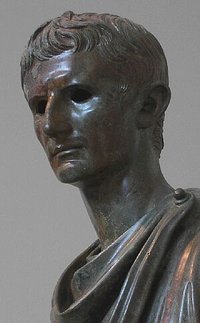1st century
2008/9 Schools Wikipedia Selection. Related subjects: General history
| Millennium: | 1st millennium |
|---|---|
| Centuries: | 1st century BC · 1st century · 2nd century |
| Decades: | 0s 10s 20s 30s 40s 50s 60s 70s 80s 90s |
| Categories: | Births – Deaths Establishments – Disestablishments |
The 1st century was that century that lasted from 1 to 100 according the Gregorian calendar. It is considered part of the Classical era, epoch, or historical period
During this period Europe, North Africa and the Near East fell under increasing domination by the Roman Empire, which continued expanding, most notably conquering Britain under the emperor Claudius ( 43). The reforms introduced by Augustus during his long reign stabilized the empire after the turmoil of the previous century's civil wars. Later in the century the Julio-Claudian Dynasty, which had been founded by Augustus came to an end with the death of Nero in 68. There followed the famous Year of Four Emperors, a brief period of civil war and instability, which was finally brought to an end by Vespasian, 9th Roman emperor, and founder of the Flavian Dynasty.
China continued to be dominated by the Han Dynasty, depite a 14 year interruption by the Xin dynasty under Wang Mang. Han rule was restored in 23; Wang Mang's rule represents the watershed between the Western/Former Han and the Eastern/Later Han. The capital was also moved from Chang'an to Luoyang.
Christianity
According to the New Testament, during the reign of Tiberius, Jesus, a religious teacher from Galilee, was crucified in Judea for bringing a new religion in the unstable region. Over the next few decades his followers carried his message far and wide, eventually introducing it to Rome itself. Roman rulers began to persecute the new sect almost immediately, and would continue to do so for centuries, sometimes vigorously, and other times passively, until Christianity was eventually taken up by the emperor Constantine, and later established as the official religion of the Roman state.
Events and economy

.
- 1: Lions became extinct in Western Europe.
- c.6: Census of Quirinius
- 8– 23: Wang Mang temporarily overthrew the Han dynasty of China.
- 9: Three Roman legions were ambushed and destroyed at Teutoberg Forest by Germans under the leadership of Arminius.
- 14: Augustus Caesar, first emperor of Rome, dies. His nephew Tiberius is his successor.
- 28– 75: Emperor Ming of Han, Buddhism reaches China.
- 27– 36: Crucifixion of Jesus Christ. Death of Jesus.
- Masoretes adds vowel pointings to the text of the Tanakh, the Hebrew Bible.
- Buddhist monks in Sri Lanka first write down Buddha's teachings, creating the Pali canon.
- Tacitus mentions the Suiones, who will one day be called the Swedes.
- Kaundinya, an Indian Brahmin marries Soma and establishes the Pre-Angkor Cambodian Kingdom of Funan.
- The Goths settle in northern Poland, which they called Gothiscandza, and shape the Wielbark culture.
- Christian Council of Jerusalem.
- 52 (?) Arrival of Apostle Thomas to Malabar, India.Beginning of Christianity in India
- July 19, 64: Great Fire of Rome, first Roman mass Persecution of Christians, earliest significant recognition of Christians in Rome.
- 66– 73 First Jewish-Roman War.
- 70, August: destruction of Herod's Temple in Jerusalem by the Romans under Titus.
- 79, August: Pompeii and Herculaneum destroyed by eruption of Mount Vesuvius.
- Jewish Council of Jamnia.
- Spread of the Roman Empire, reaches largest size under Trajan.
- Arena (colosseum) is constructed, origin of the name Arena.
- Late 1st century — Cityscape, detail of a Second Style wall painting from a bedroom in the House of Publius Fannius Synistor, Boscoreale, is made. It is now at The Metropolitan Museum of Art, New York.
- The painting "Alexander the Great confronts Darius III at the Battle of Issos", detail of mosaic floor decoration from Pompeii, Italy is made. It is a Roman copy after a Greek painting of c. 310 BC, perhaps by Philoxenos or Helen of Egypt. It is now at Museo Archeologico Nazionale, Naples, Italy.
Significant people
- Apollonius of Tyana
- Akiba
- Arminius
- Boudica, also known as Boadicea
- Augustus
- Caligula
- Claudius
- Clement I of Rome
- Decebalus
- Domitian
- Du Shi
- Elisha ben Abuyah
- Galba
- Germanicus
- Guangwu of Han, Emperor
- Hero of Alexandria
- Hillel the Elder
- Ignatius of Antioch
- James the Just
- Jesus of Nazareth
- John the Baptist
- Josephus
- Liu Xin
- Livy
- Ma Yuan
- Ming of Han, Emperor
- Nero
- Nerva
- Otho
- Paul of Tarsus
- Philo
- Pliny the Elder
- Pontius Pilate
- Seneca the Younger
- Strabo
- Tacitus
- Thomas the Apostle
- Tiberius
- Titus
- Trajan
- Vespasian
- Vitellius
- Wang Chong
- Wang Mang
Inventions, discoveries, introductions
- Codex, the first form of the modern book, appears in the Roman empire
- Year 78 — the beginning of the Saka Era used by South Asian calendars.
- Bookbinding
- Various inventions by Hero of Alexandria, including the steam turbine (aeolipile), vending machine, water organ, and various other water-powered machines.
- In 31, the Han Dynasty Chinese engineer and statesman Du Shi (d. 38) from Nanyang invented the first-known hydraulic-powered bellows to heat the blast furnace in smelting cast iron. He used a complex mechanical device that was powered by the rushing current against a waterwheel, a practice that would continue in China.
- Although Philo of Byzantium described the saqiya chain pump in the early 2nd century BC, the square-pallet chain pump was innovated in China during this century, mentioned first by the philosopher Wang Chong around 80 AD. Wang Chong also accurately described the water cycle in meteorology, and argued against the mainstream 'radiating influence' theory for solar eclipses, the latter of which was accepted by many, including Zhang Heng.
- The Chinese astronomer Liu Xin (d. 23) documented 1080 different stars, amongst other achievements.
Decades and years
|
|||||||||||||||||||||||||||||||||||||||||||||||||||||||||||||||||||||||||||||||||||||||||||||||||||||||||||||||||||||||||||||||||||||||||
|
|||||||||||||||||||||||||||||||||||||||||||||||||||||||||||||||||||||||||||||||||||||||||||||||||||||||||||||||||||||
|
|||||||||||||||||||||||||||||||||||



